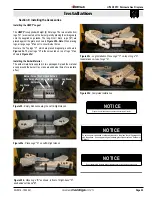
Page 31
H*38DF PFC Peninsula Gas Fireplace
XG0816 - 150204.1
Maintenance
Lighting Instructions
See pages 25 to 27.
Due to high operating temperatures, this appliance should be located out of traffic &
away from furniture and draperies.
Children and adults should be alerted to the hazards of the high surface temperature,
which could cause burns or clothing ignition.
Young children should be carefully supervised when they are in the same room as the
appliance.
Clothing or other flammable materials should not be placed on or near the appliance.
CAUTION
General
Have the fireplace and installation inspected yearly
. The
inspection must include, but is not limited to, the following:
• A visual check of the entire vent system and termination.
• An inspection of the explosion relief flappers and the door
gaskets to ensure a proper seal.
• An inspection of the burner, vent run, and primary air openings.
• An inspection of the gas valve, gas components, and pilot
flame. For your convenience a 1/8" manifold pressure tap
is supplied on the gas valve for a test gauge connection.
• Ensure proper log placement as per this manual.
• Inspection of all optional equipment; fans, thermostats, etc.
• Inspection of all glass doors and screen for damage and
proper installation
For
Natural Gas
this appliance requires a minimum inlet pressure
of 5.5" W.C. and a manifold pressure of 3.5" W.C.
For
Propane Gas
this appliance requires a minimum inlet
pressure of 11" W.C. and a manifold pressure of 10" W.C.
Always keep the fireplace area clear and free of combustible
materials, as well as gasoline and other flammable vapours
and liquids.
Do not use this appliance if
any part has been under water
.
Immediately call a qualified service technician to inspect the
appliance and to replace any part of the control system and any
gas control which has been under water.
Cleaning
When the fireplace is first activated, there may be some smoking and
a visible film may be left on the glass. This is a normal condition, and is
the result of burning of protective coatings on new metal.
Glass must be cleaned periodically to remove any film (which
is a normal by-product of combustion) which may be visible.
Film can easily be removed by removing the door, as shown on
Page 21
. Handle the door carefully, and clean it with nonabrasive
glass cleaners. One of the most effective products is Kel Kem.
Silicone seals on inner door during initial firing will "off gas",
leaving a visual deposit of a white substance on combustion
chamber walls. This can easily be removed from the chamber
walls using normal household products.
Use a vacuum cleaner or whisk broom to keep the control
compartment, burner, and firebox free from dust and lint.
Logs may be cleaned periodically with a vacuum to remove soot
or other contaminates.
Hi-Lo Burner Adjustment: (SIT Nova 820)�
The
H*38PF*
is equipped with an adjustable burner, allowing you to
raise or lower the flames. To adjust the flames, locate the black knob
marked 'Hi-Lo', in the centre of the gas control valve (See
Figure 29
).
To raise the flame height, turn the black knob (located behind the
lower control compartment)
counter-clockwise
.
To lower the flame height, turn
clockwise
.
Figure 29�
'Hi-Lo' Adjustment on the SIT Nova 820 gas valve,
Pilot Burner Adjustment�
1�
Locate Pilot Adjustment Screw.
(See
figure 29.
)
2�
Adjust pilot screw to provide properly sized flame as shown.
3�
After installing or servicing, leak test with a soap solution with main
burner on. Coat pipe and tubing joints, gasket etc. with soap solution.
Bubbles indicate leaks. Tighten any areas where the bubbles appear
until the bubbling stops completely.
Manifold Pressure
Test Connection
Wall Switch
Power
Generator
Pilot Adjustment Screw
Inlet Pressure
'Hi-Lo' Adjustment Knob
Gas Control Knob (Shown in “Pilot” position)
Maintenance








































